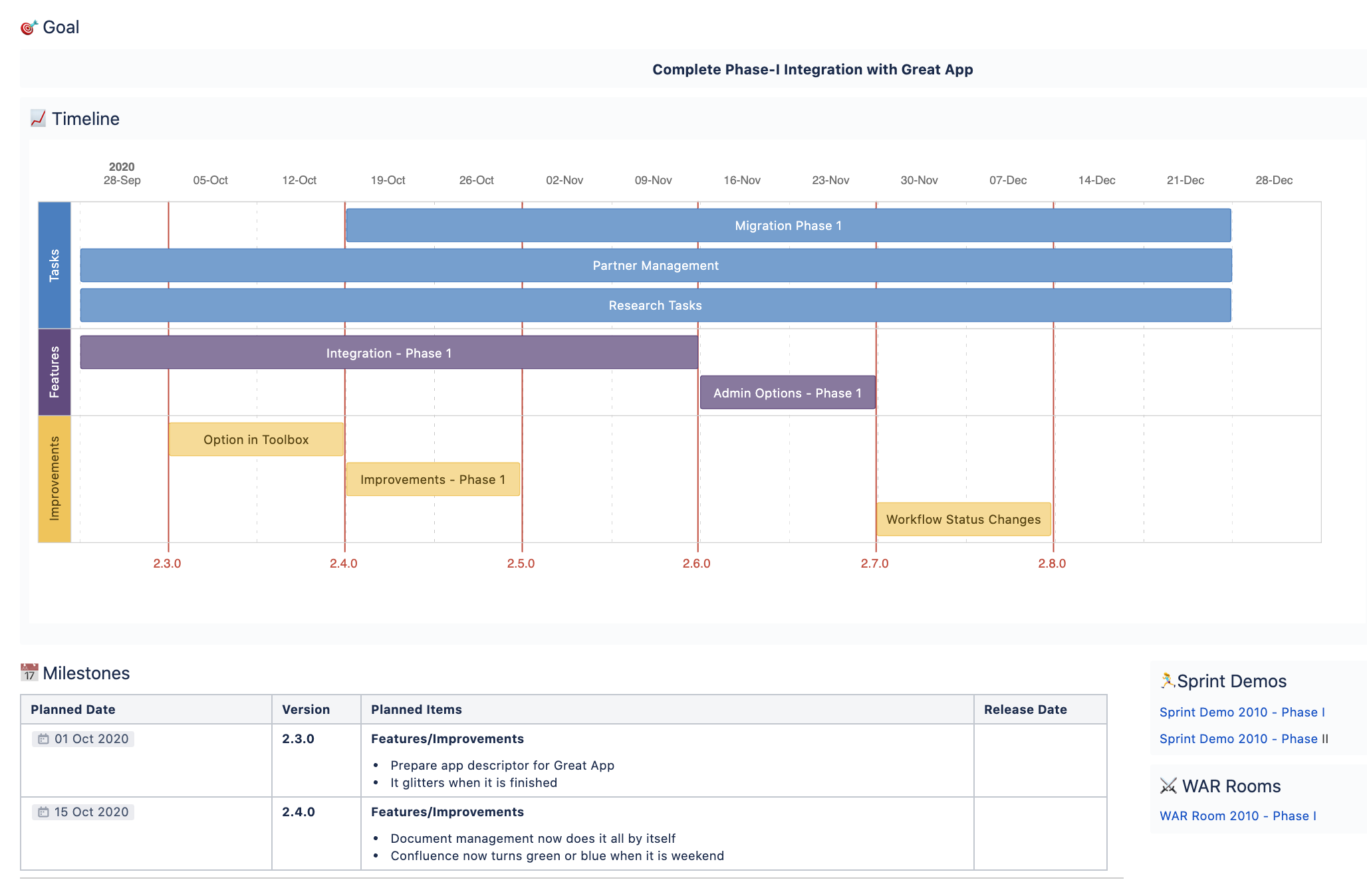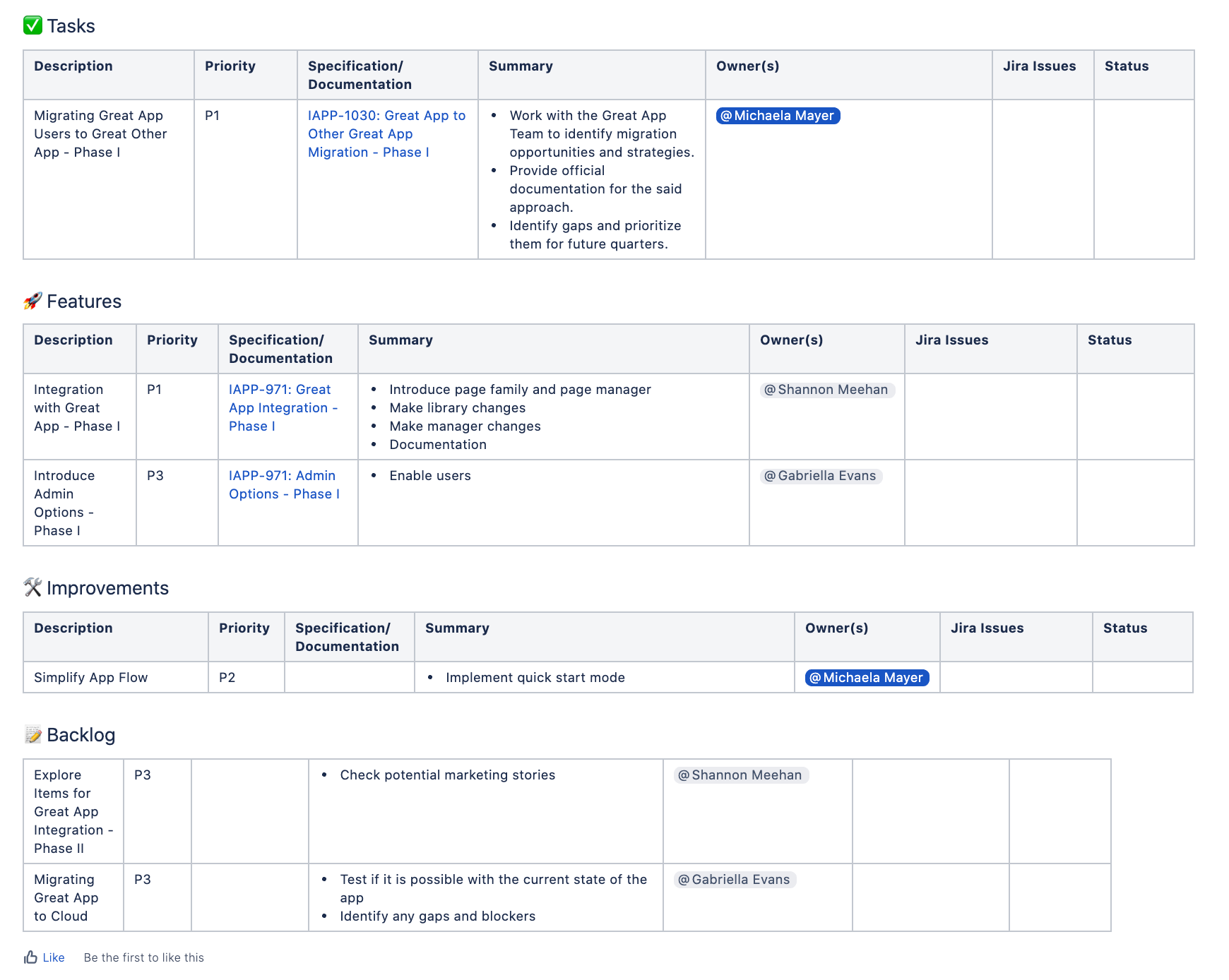Build a Roadmap Template in Confluence: When All You Need is a Page

Build a Roadmap Template in Confluence: When All You Need is a Page
A Short Definition of Roadmaps
In the beginning, when you have to decide on how a roadmap template could look, you have to consider how the roadmap should work in a particular project or team. There are many types of roadmaps, but they all have one thing in common: they represent a strategic plan that defines a goal, with associated milestones to achieve it. It's a communication tool to align individuals, teams, and stakeholders around the same goals and should always include the WHAT and WHY of each single task.
This blog post focuses on a quarterly product roadmap in Confluence but is just as useful for other types of roadmaps that need to be set up quickly and precisely.
Create a Great Roadmap Template in Confluence
Confluence is a great tool for building an efficient and goal-oriented product roadmap. One page is enough for all the components you need for your quarterly focus on tasks, features, and improvements.
Here's an example of how K15t's product roadmap might look in its first stages. It's one organized page where all necessary information is clearly arranged in one place. At K15t we use further meeting types like brainstorming rounds, in addition to our product roadmap planning, which serves as a way to continuously improve our roadmap based on feedback both in and outside the team.
The following section explains the basic components you need to create a roadmap template with a well-thought-out structure in Confluence.
The Components of the Confluence Roadmap Template We Use at K15t
Once the page structure has been created and plans are made you can start to build your template. Adjust now the main page with the actual roadmap in Confluence directly and add the necessary items that are useful for your roadmap template.
- The Title:
The roadmap page in Confluence needs a good title: Clearly defined, tells a story, could be based on intended milestones. This is your chance to be creative. - The Goal:
The goal of this particular product roadmap describes what the team wants to achieve this quarter. For example, a complete integration. - The Timeline:
The roadmap template is incomplete without a visual timeline. It translates the page content into a visual representation of the product roadmap and its milestones. It showcases the potential dependencies, gives individuals a clearer picture of how they can plan their activities and offers a clear idea of how and when things can be built.
It's easily created via the Confluence Roadmap Planner and contains tasks, features, and improvements. - The Milestones:
Milestones – presented in a simple table with planned items and deadlines – are an essential part of the roadmap. Use also milestone marks in the roadmap timeline via the Confluence Roadmap Planner feature to show major achievements over time. - The Link Collection:
On the right-hand side of the page are two boxes implemented with the Confluence macro 'Content by Label'. This is the home where links of child pages and other related content is kept. Now everyone can find everything in one place. - The Initiative:
The initiative in every product roadmap is broken down into table columns: tasks (things like marketing campaigns or research), features (like adding a new component to the app), and improvements (like improvements for a certain UI). The 'summary' column of the initiatives section should reflect the why of all tasks, features, and improvements.
Last but not least, there is the backlog that is used for tasks that cannot be picked up yet.
This is an example of K15t's product roadmap in its next phase once plans have been discussed and are more concrete.
You now know the most important items that define an efficient roadmap template in Confluence. We'll move on to the process of creating a product roadmap.
The Process of Creating a Roadmap in Confluence
Let's take a look at the process of building a product roadmap, and see how to develop goals. These next three steps will guide you towards creating and implementing your own roadmap.
Step 1: Creation of a Proposal
Create a section for the product roadmap in the Confluence space with a consistent title and goal. Initially, the main tasks, features, and improvements should be added. Always keep in mind the goal of the quarter, the company-wide priorities, and the long-term goal of the company. Feedback from previous retrospectives should also play a role.
Step 2: Discussion, Alignment, and Ownership
In this step, everybody involved should have the chance to go through the initial draft to share their input and add new tasks if necessary. Discuss the initial draft, paying close attention to any blockers or new additions from team members. Then the second draft of the roadmap can be created and the ownership for every task should be assigned. The owner doesn't have to execute every single task but is responsible for getting things done, addressing blockers, coordinating between team members, and so on.
At the end of this step, the roadmap has to be cleaned and initial statuses set up.
Step 3: Presentation to Stakeholders
A simple but important step is to present the product roadmap in Confluence to all stakeholders. At this point, feedback should be collected and any inconsistencies identified so that they can be incorporated into the roadmap. This step is also essential to ensure that everyone has the same goal in mind and that the roadmap is aligned with the strategic priorities of the company.
After these three steps, it is important to commit to the plan and execute it. But of course, it is always advisable to remain flexible and not to be caught off guard by unforeseen events.
We Created a Help Center in Confluence and You Can Too
Want to learn more about building your own help center on Confluence?
Read the blog post to learn why we chose Confluence to build and run our own help center, and see how easy it is to set up.
Learnings and Best Practices for Product Roadmapping
The K15t app teams have been working with product roadmaps for many years and as a result, the following tips and tricks have been well tested.
- Start as early as possible - Set reminders! With sufficient time for preparation, you can identify blockers and changes.
- Be realistic but dream big - Aim high, but don't over-commit as it can be demotivating if you're unable to achieve everything you set out to do.
- Focus on the why - Each team member and stakeholder should understand why the goal and the tasks are set in this particular way.
- Keep it short and simple - Don't micro plan! It costs you more time than necessary and leaves little room for flexibility within the team.
- Share the ownership - Everybody should be aware of who owns what aspects of the roadmap at any given time.
- Review regularly - Be flexible and review the roadmap from time to time.
Presenting Your Roadmap Externally
What happens if you want to present the finished product roadmap to your investors or customers, who usually don't have access to your internal Confluence space?
The Atlassian Marketplace has apps that help you create good looking documents out of your Confluence space. At K15t, we use Scroll Documents for Confluence . The app allows you to manage a Confluence page tree and all child pages as one unit. The result is a clearly arranged document with subchapters and clickable links. Finally, you can even export this document as a PDF and send it to external parties.
Get the Team Onboard With Your New Roadmap Template in Confluence
Congratulations! You now have your roadmap template in Confluence that can be used over and over again. Now its time to share it with your team-mates. With a well thought out product roadmap, everybody can get on board and know exactly how to reach the team's goal.

